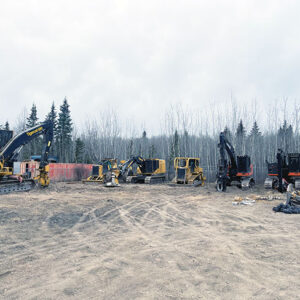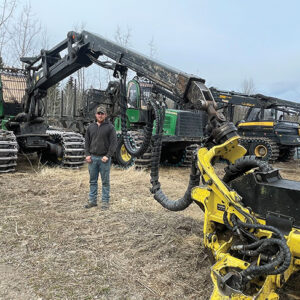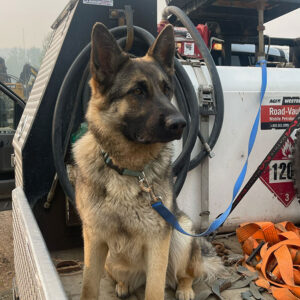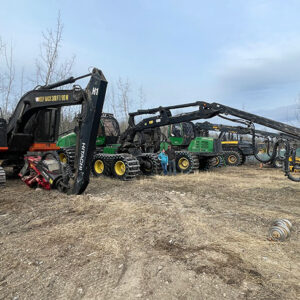
Features
Logging Profiles
Big leap: From apprenticeship to entrepreneurship
Lane Mazereeuw takes bold leap into logging amidst economic challenges
June 19, 2023 By Jennifer Ellson
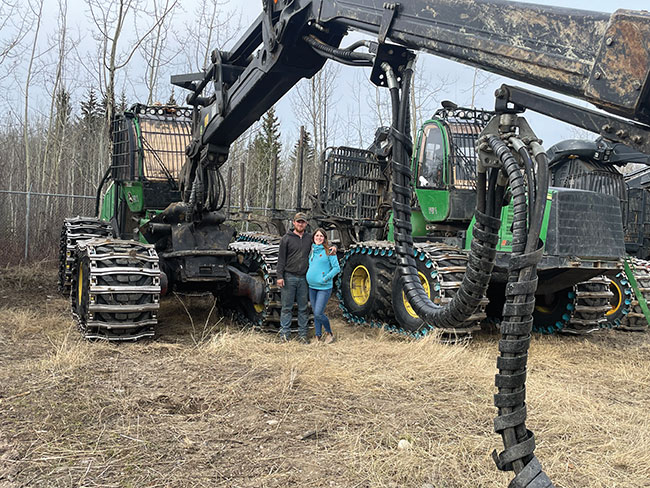 Big year, big leap: Lane and Hannah Mazereeuw are expecting their first born in June. Photos courtesy of Mazereeuw family.
Big year, big leap: Lane and Hannah Mazereeuw are expecting their first born in June. Photos courtesy of Mazereeuw family. Taking the entrepreneurial leap is a big feat. Doing it in your 20s is a massive undertaking. Taking that leap during the pandemic, in high inflation and economic crunch is just gutsy. Lane Mazeereuw, 26, did just that in late 2022, incorporating Mazereeuw Timber Ltd. in Vanderhoof, B.C.
“It’s the toughest time to be in the industry. I’ve been told, ‘you’re crazy for getting involved in logging – can’t you see what’s happening?’” Mazereeuw smiles as he recalls the company’s start over a cup of coffee. Mazereeuw sat down with Canadian Forest Industries in neighbouring Prince George, B.C., in April and spoke about the highs and lows of starting a logging company in today’s business climate.
From just an idea to reality
Mazereeuw is used to hard work, being raised on a ranch. His family has been involved in the logging and cattle industries since his grandfather moved to Canada from the Netherlands after World War II. His father, Matt Mazereeuw, 51, ventured into silviculture, introducing his son to logging at a young age.
“I started at 15, first with hand-slashing on power lines for Stephen Bros. Contracting, until I was old enough to get a driver’s license.”
That driver’s license allowed him to do an apprenticeship, which proved to be a game-changer, as he learned skills that then allowed him to spread his wings and work for other contractors.
“It was a big learning curve. They run their own fleet of custom-built mowing machines, so I learned how to maintain those machines and be trained as a heavy-duty mechanic.”
He moved on to do repairs and maintenance work on a fleet of 30 pieces of logging equipment for Walter Neufeld Contracting (WNC). He then worked for Brandt Tractor, exposing him to more equipment used in other industries, while also learning about running a dealership business and acquiring people skills in the process.
A decade after, at the ripe age of 25 and supported by his wife Hannah Mazereeuw, he invested and bought logging and roadbuilding equipment from WNC to start Mazereeuw Timber in Nov. 2022.
Fleet and family
Mazereeuw’s fleet is impressive, consisting of a Tigercat 880 loader; a Tigercat 630E skidder; a Tigercat X870D buncher; a Hitachi 210 excavator with a WBM power clam, plus digging and cleanup buckets and rake; a Hitachi 210 processor with a Waratah 622B head; a John Deere 1270G harvester; a John Deere 1910E forwarder; a Ponsse Scorpion harvester; a Ponsse Elephant King forwarder; a Caterpillar D7R XR2 crawler dozer; a 2019 Western Star 4900SB with a Peerless lowbed; and a 2018 Freightliner M2 rigged with Brutus service body.
“For operators, I have a guy for each machine. We do all our own low bedding and road building. My dad is the man behind all of that. Hauling distances are very dependent on the block – trucks make anywhere from one to three trips to the mill a day.”
Buying the equipment involved a massive investment, but where the huge savings come is in the upkeep of these expensive machines.
“Maintenance is a very big part of the cost of running a business, but I am very familiar with this fleet of equipment and the biggest advantage for me is that I can fix all of it myself.”
His wife Hannah is also very much involved in running the show, even in her current pregnancy phase. The 22-year-old is due to give birth to the couple’s first child in June, but is keeping herself busy supporting the logging business by handling paper works, safety matters, even manual labour sometimes and moral support at all times.
“My wife helps with running parts, piloting machines on the move, even helps me fix machines, and is a huge moral support.”
His army also includes his mother Barb, 45, who helps with banking and bookkeeping, among other duties.
“She also details all the machines and pickups for me a couple times a year, and makes sure all our safety equipment is current and present in all the machinery and pickups.”
Lastly, he gets plenty of support, safeguarding and a lot of licks from Mae, his German shepherd, who he describes as the real boss.
Business at a glance
Mazereeuw’s target as far as volume is to move roughly 130,000 cubic metres a year in any form of wood, from 0.15-0.75 cubic metre per piece. The tree size that they harvest is usually from 6- to 30-in. in diameter, but more commonly on the lower end of the scale.
“This is more of a specialized take on logging. We are very focused on the finish product as far as what gets sent in, but more so what we leave the bush looking like. This needs to be a sustainable industry. How we leave these sites matters to us as much as anything. We’ll always be working in the cut-to-length sector, with max piece length at 33 ft.”
He adds, “That’s about the max that we will put on the forwarders. But lots of lengths are cut in the 12- to 20-ft. range as well. I log mostly pine and spruce. Some stands have pretty large amounts of balsam but that is about the big 3. We have done some blocks that go almost entirely to pulp.”
When in full production, an average day is “never really shorter than the 12-hour mark when driving is included.”
All the timber goes to Canfor’s Plateau sawmill in Vanderhoof. Sometimes the wood is sold through Canfor and winds up at other local mills.
Pulp goes to Arrow Group of Companies’ biomass power generation facility in Fort St James. Some goes to BC Custom Timber Products in Vanderhoof to be chipped.
“The pulp outlet is a huge asset. It allows us to get maximum utilization out of every piece we handle and erases the need for burn piles, especially when we are using these harvesters and forwarders. All the limb debris is left where the tree is harvested to break down and get right back into the ecosystem.”
Business not as usual
Although he is excited for the future, he acknowledges that times are hard.
“Now is a pretty rough time, especially with a startup – it’s a big load on the shoulders, that’s for sure,” he sighs. “I’m trying not to focus on all the negatives in the industry and the economy, however payments never cease to show up and the bank account always needs to be topped up.”
Mazereeuw says he has to keep options open for work – whatever it may be – to keep his company above water.
“I’m relying heavily on my roots as a heavy-duty mechanic to pick up some income and stay busy while the world figures itself out. I think there’s a future in logging, not with clear cutting and leaving wide open acres in the bush, but with the selective approach we are taking with the harvesters and forwarders and focusing largely on retention,” he says.
“There is not a lot of guys logging in this style in the area, so it’s tough to get the idea of what can be done in the bush out there.”
As far as old growth trees, Mazereeuw says anyone who works in the bush can see that forests need to be managed.
“Not clearcutting, but selectively picked through and groomed to something that will prevent the wildfires we’ve had. Also, to get rid of old rotten growth and blow down trees, which will only promote the growth of juvenile timbers, which is the future of our forests. It will also promote stewardship of the animals in these areas.”
While his main priorities will soon include his newborn, he is looking forward to continue building his business, with the goal of passing it on to his children in the future.
Print this page
